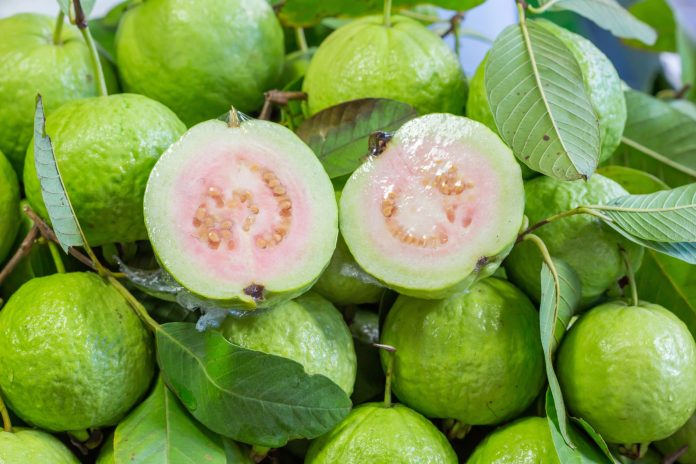Rapid spread of nematode infection linked to foreign guava varieties introduced in the last decade
LUCKNOW, Sep 21 (The CONNECT) – Guava, the poor man’s apple, is facing crisis due to a severe nematode infection.
The Central Institute of Subtropical Horticulture (CISH) has recently raised the alarm following which the government is contemplating action to protect the interests of guava orchardists.
The infection, which arrived with foreign varieties like Thai Pink and Taiwan Pink, is spreading rapidly. Currently, nearly half of the state’s guava orchards are believed to be affected.
According to a five-year survey conducted by CISH, which operates under the Indian Institute of Agricultural Research (ICAR), the nematode infection is a major crisis for guava crops. Dr. T. Damodaran, the institute’s director, emphasized the seriousness of the situation, highlighting the negative impact on fruit quality, yield, and the increased cost of production for orchardists.
While eliminating the nematode infection entirely is not possible, managing it to some extent has been found achievable, albeit with challenges. The use of fluopyram, a chemical treatment, has shown some success but is costly and offers only temporary relief, lasting around six months.
Experts recommend treating the soil and roots of infected grafts with a 0.05% fluopyram solution, 15 days before transplanting them into the main field. Each graft should be planted as deeply as possible, with 2 liters of the fluopyram solution applied per plant for optimal results. Proper field selection is also crucial, as heavy soils can help suppress nematode activity.
Preventing root-knot nematodes in newly established guava orchards is key. This can be achieved through the continuous use of bio-agents, such as ICAR’s Fusikont and CISH’s bacterial bio-agents. Additionally, scientists have identified rootstocks like Psidium cattleyanum and inter-specific Moley rootstock, which exhibit high tolerance to nematodes. Efforts are underway to rapidly multiply these rootstocks to aid in disease management.
Bio-control agents such as trichoderma harzianum, pocconia chlamydosporia, purpurecillium lilacinum, and bacillus amyloliquefaciens have also proven effective in managing nematode infestations, although they require frequent reapplication. Incorporating nematode-resistant crops in intercropping and using organic products have shown moderate success in controlling the spread of the infestation.
Studies conducted by Dr. P.K. Shukla, a pathologist at the Central Institute of Subtropical Horticulture (CISH), have revealed that foreign guava varieties are highly susceptible to nematode infections, whereas traditional Indian varieties like Allahabad Safeda, along with indigenous varieties such as Dhawal, Lalit, Lalima, and Shweta, show greater tolerance. To protect guava orchards from nematodes, farmers, gardeners, and home growers are encouraged to plant these native varieties, which are also preserved and recommended by CISH.
Both the Central and State Governments have presented varieties like Shweta and Lalit, ensuring that only authorized nurseries that have acquired the proper technology from the source institute are allowed to sell them. Authorities are urged to take strict action against nurseries and plant producers who sell these varieties illegally.
Additionally, CISH scientists, including Dr. Prabhat Kumar, have developed a technology to prevent the spread of nematodes through planting material, further aiding in the protection of guava crops.
Some guava crops which have been recommended to beat the infection are:
Lalit: This variety is known for its vibrant saffron-yellow exterior with an attractive red glow and pink, firm pulp. It offers an excellent balance of sugar and acidity, making it ideal for both fresh consumption and preservation. Remarkably, the pink color of its pulp remains intact for up to a year after preservation. With an average yield 24% higher than the popular Allahabad Safeda variety, Lalit is highly suitable for commercial cultivation.
Shweta: This high-yielding variety was selected from seed-bearing plants of the apple-colored guava. It produces slightly round fruits with soft seeds, each weighing around 225 grams. Under optimal management, a tree can yield around 90 kg of fruits per season, making it a great choice for gardeners and farmers.
Dhawal: Known for producing 20% more fruit than Allahabad Safeda, Dhawal’s round, smooth fruits weigh between 200-250 grams each. When ripe, the fruits have a light yellow color and sweet, mildly flavored white pulp. The seeds are also relatively soft, adding to its appeal for fresh consumption.
Lalima: Selected from the Apple Guava variety, Lalima features red-colored fruits weighing approximately 190 grams each. It is valued for its good yield and is another promising variety for commercial production.
Guava orchards can thrive on a variety of land types, but sandy loam soil with proper drainage is most suitable. When planting guava trees, it is essential to maintain a standard distance of 5 to 6 meters between each plant and row. This spacing ensures proper growth and allows for intercropping during the first four to five years while the trees are still maturing. Seasonal crops can be planted in the interim, providing additional income to farmers.
Guava, known for its distinct taste and aroma, is a powerhouse of nutrients, making it a valuable fruit for both health and economic purposes. According to T. Damodaran, Director of the Central Institute of Subtropical Horticulture, guava is rich in vitamin C, sugar, pectin, minerals, and fiber, earning it the nickname “Amrit fruit” or “the apple of the poor.” Beyond being consumed fresh, guava can be processed into a variety of products such as chutney, jelly, jam, juice, and marmalade, making it versatile in the food industry.
Sushil Shukla, a senior scientist at the institute, suggests that combining guava orchards with mango plantations can enhance income for orchardists. To do this, mango trees should be spaced 10 meters apart, while guava plants can be planted at a distance of 5 meters between each plant and row. This method allows for a significant number of guava trees to be incorporated into the orchard, ensuring a steady and profitable yield over a longer period. This intercropping strategy provides gardeners with better income opportunities and maximizes land use efficiency.
In addition to these, guava is also rich in essential minerals and vitamins, including calcium, phosphorus, thiamine, riboflavin, niacin, and iron, making it a highly nutritious fruit that supports overall health and well-being.




